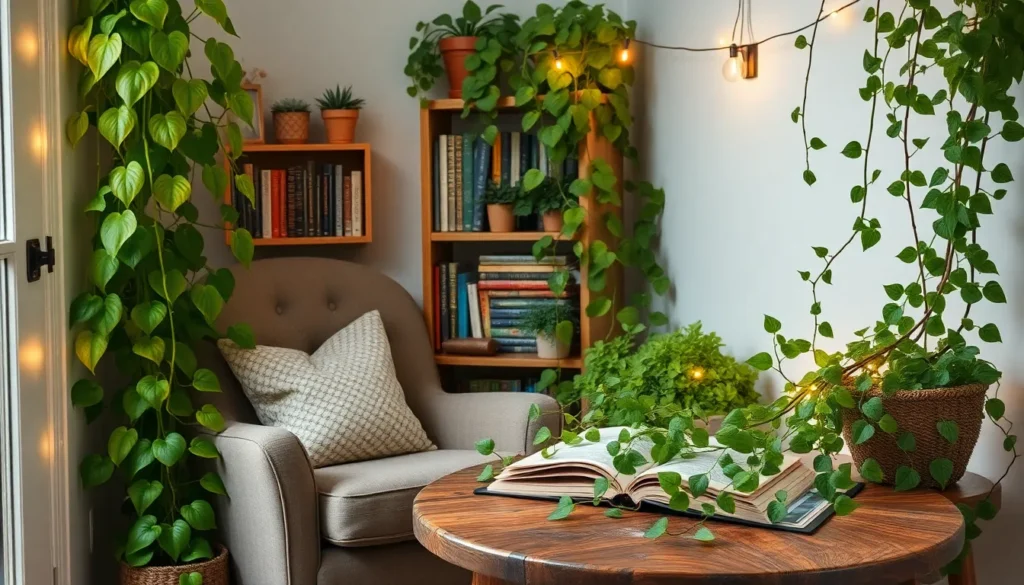We’ve all felt that instant sense of calm when we walk into a room filled with books and greenery. There’s something magical about the way literature and plants complement each other – creating spaces that feel both intellectual and nurturing. This timeless aesthetic has captured hearts across social media platforms and transformed countless homes into Instagram-worthy sanctuaries.
The books and plants aesthetic isn’t just about pretty pictures. It’s about crafting environments that inspire creativity while promoting mental well-being. When we surround ourselves with the wisdom of books and the life force of plants we’re creating more than just visual appeal – we’re designing spaces that feed our souls.
Whether you’re a seasoned plant parent with towering bookshelves or someone just starting to explore this enchanting combination we’ll show you how to master this beloved aesthetic. From choosing the perfect plant companions for your favorite reads to styling techniques that’ll make your space absolutely irresistible.
Create a Cozy Reading Nook With Trailing Plants
Trailing plants transform any reading space into a verdant sanctuary where literature and nature converge seamlessly. We’ll show you how cascading greenery creates the perfect backdrop for your literary adventures.
Position Pothos and Ivy Near Your Favorite Reading Chair
Position golden pothos on a side table within arm’s reach of your reading chair to create an intimate green border. These low maintenance plants thrive in indirect light and their heart shaped leaves add visual softness to angular furniture pieces. We recommend placing English ivy on floating shelves at eye level where its trailing vines create natural curtains around your reading space.
Drape trailing stems over chair backs to establish a living canopy effect that enhances privacy and focus. Devil’s ivy works particularly well for this technique since its vines can grow up to 10 feet long and adapt to various lighting conditions. Position multiple plants at different heights around your chair to create layers of cascading greenery.
Select varieties that complement your reading habits by choosing plants that won’t require frequent maintenance during long reading sessions. Pothos varieties like Marble Queen and Neon thrive with weekly watering while providing stunning visual contrast against dark colored furniture.
Use Hanging Planters to Frame Your Book Collection
Install ceiling hooks directly above your bookshelf to create vertical growing space that draws the eye upward and makes rooms appear larger. Macrame plant hangers work exceptionally well with trailing varieties like String of Hearts or String of Pearls that cascade down to frame book spines beautifully.
Choose planters that match your aesthetic preferences while ensuring proper drainage to protect your books from water damage. Terra cotta hanging pots complement rustic book collections while sleek ceramic vessels enhance modern minimalist libraries. We suggest positioning hanging plants 18 to 24 inches away from bookshelves to prevent moisture issues.
Create depth with multiple hanging levels by installing hooks at varying heights to establish a cascading forest effect. Place longer trailing plants like Philodendron Brasil higher up while shorter varieties such as Baby Tears work perfectly at intermediate levels.
Add String Lights for Ambient Reading Atmosphere
Weave warm white LED strings through trailing plant stems to create a magical reading environment that reduces eye strain during evening reading sessions. These lights highlight the natural curves of vines while providing gentle illumination that won’t disturb your focus on the page.
Install battery operated fairy lights with timers to eliminate cord clutter around your reading nook while ensuring consistent ambient lighting. We recommend choosing lights with 2700K color temperature that mimics natural candlelight and complements both plant foliage and book pages.
Position lights to illuminate both plants and reading materials by creating multiple light sources at different angles throughout your nook. Tuck small LED strips behind trailing plants to create stunning silhouette effects against walls while maintaining enough brightness for comfortable reading.
Style Your Bookshelves With Low-Maintenance Greenery
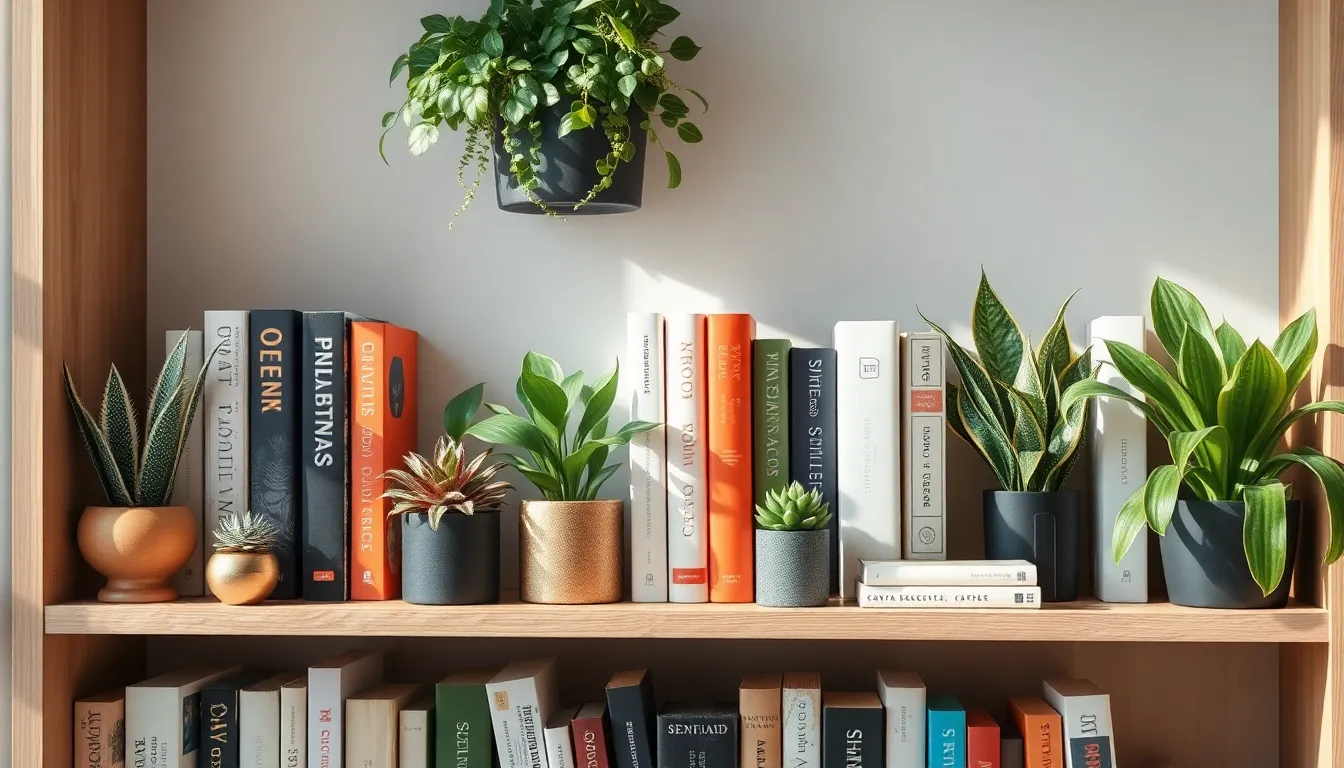
Transforming your bookshelves with easy-care plants creates stunning visual appeal without demanding constant attention. Low-maintenance greenery like succulents and snake plants thrives indoors while adding texture and color contrast to your literary displays.
Place Succulents Between Book Spines for Visual Interest
Succulents wedged between books break up monotonous rows of spines and introduce delightful spots of green throughout your collection. Small varieties like echeveria or jade plants fit perfectly between larger volumes, creating ever-changing visual breaks that guide the eye across each shelf. These drought-tolerant beauties require minimal watering and flourish in the indirect light that most bookshelves receive.
Position your succulents strategically to create rhythm and balance across multiple shelves. Vary their placement heights and spacing to avoid predictable patterns that might feel too structured. The compact size of most succulents makes them ideal for narrower shelves where larger plants would overwhelm the space or obstruct book access.
Use Small Potted Plants as Natural Bookends
Small potted plants serve dual purposes as functional bookends and organic decorative elements that soften rigid bookshelf lines. Replace traditional bookends with sturdy plants like small snake plants or ZZ plants that can support leaning books while adding natural beauty to your arrangements. These plants’ upright growth patterns and substantial root systems provide the stability needed to keep books properly organized.
Consider using matching planters on opposite ends of the same shelf to create visual symmetry. Terra cotta pots complement the warm tones of book spines beautifully, while sleek ceramic containers work well with modern minimalist aesthetics. The height variation these plant bookends provide adds architectural interest to your shelving displays.
Create Height Variation With Cascading Plant Arrangements
Cascading plants like pothos or string of pearls placed on top shelves create dramatic waterfall effects that add depth and movement to bookshelf designs. These trailing varieties soften harsh edges and introduce organic curves that contrast beautifully with the geometric lines of books and shelving. Position them where their vines can drape naturally without blocking access to frequently used books.
String of pearls creates particularly striking cascades with its unique bead-like foliage that catches light beautifully as it flows downward. Golden pothos offers lush green trails that can extend several feet, making it perfect for taller bookshelves where you want to draw the eye upward. Both plants tolerate low light conditions and infrequent watering, making them perfect choices for busy book lovers.
Choose the Perfect Plant Pots to Complement Your Book Covers
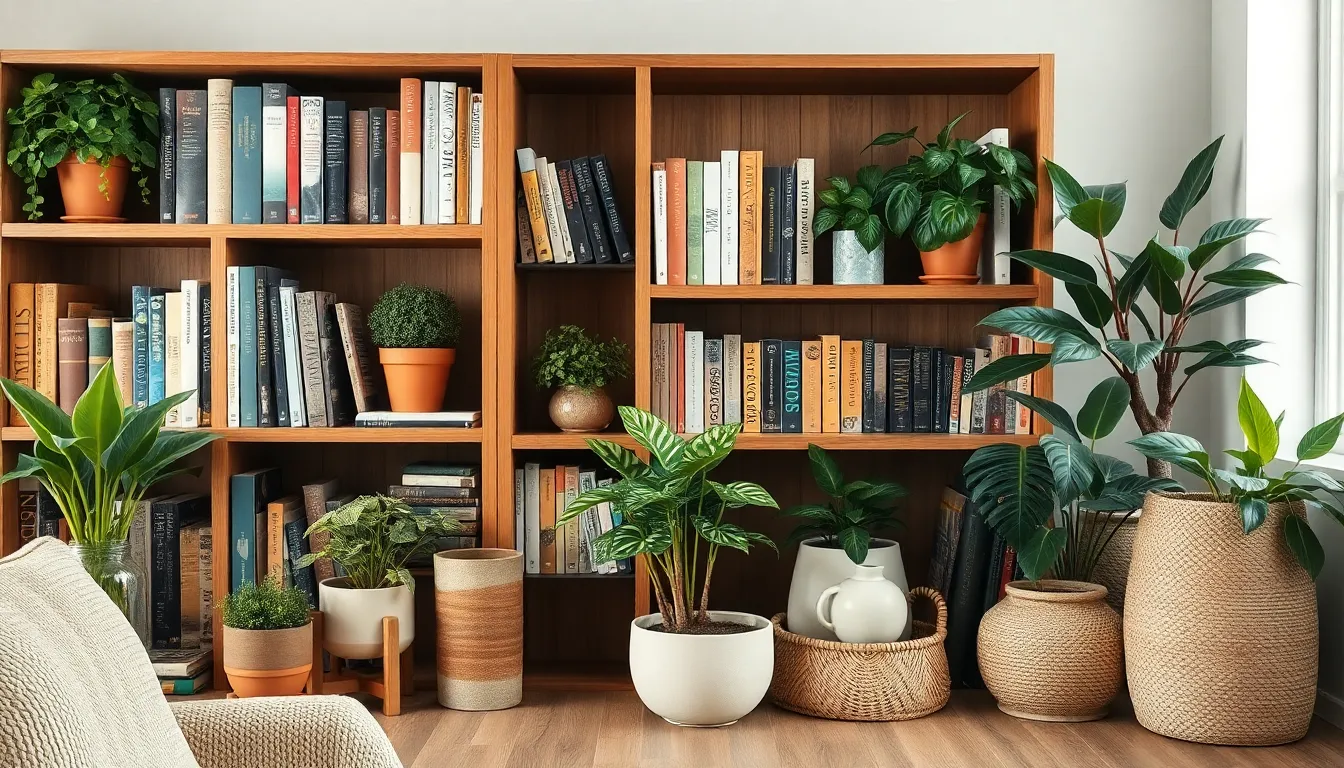
Selecting the right plant pots transforms your book and plant displays from ordinary arrangements into cohesive design statements. We’ve discovered that matching pot styles to book collections creates visual harmony that elevates your entire reading space.
Match Terracotta Pots With Vintage Book Bindings
Terracotta pots create stunning partnerships with vintage book collections featuring leather or fabric bindings in rich browns, reds, and ochres. The warm earthen tones and rustic texture of terracotta naturally echo the timeless appeal of classic book spines. We love how these clay vessels enhance the nostalgic atmosphere of traditional libraries while maintaining that cozy, well-loved feeling. Position terracotta planters alongside your vintage hardcovers to amplify the aged charm and create focal points that celebrate both literary history and natural beauty. The weathered appearance of terracotta adds authentic character that complements the patina found on antique book covers.
Select Neutral Ceramic Planters for Modern Book Collections
Neutral ceramic planters offer the perfect backdrop for contemporary book displays characterized by sleek covers and minimalist design. White, beige, and grey ceramics with smooth finishes emphasize clean lines without competing for visual attention against modern book spines. We recommend choosing planters with simple geometric shapes that mirror the structured aesthetics of current publications. These sophisticated vessels maintain the polished, curated appearance that modern book collections deserve while adding subtle texture through their matte or glossy finishes. Contemporary ceramic pots create breathing space between bold book covers and allow the typography and graphic design elements to shine.
Incorporate Woven Baskets for Bohemian Reading Spaces
Woven baskets bring organic texture and artisanal warmth to eclectic book collections filled with colorful, varied covers. The natural fibers and handcrafted appearance of woven planters complement the layered textiles and mixed patterns typical of bohemian aesthetics. We find that these baskets create visual balance against busy book spines while adding depth through their three-dimensional weaving patterns. Choose baskets in natural materials like seagrass, jute, or water hyacinth to enhance the relaxed, creative atmosphere of boho reading nooks. The flexible nature of woven containers allows you to experiment with different plant heights and create ever-changing arrangements that feel both intentional and effortlessly styled.
Design Instagram-Worthy Flat Lays With Books and Plants
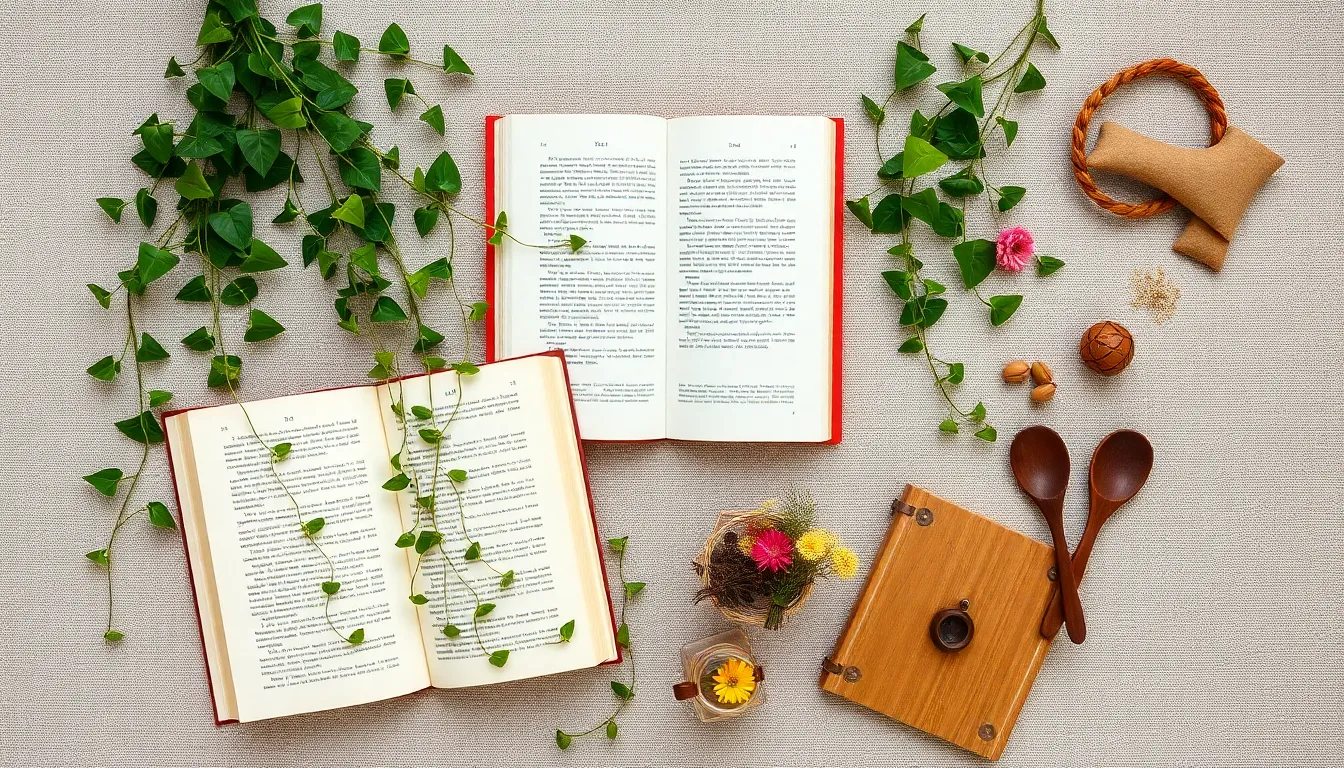
We’ll transform your reading collection into stunning flat lay compositions that capture the perfect blend of literature and nature. These arrangements create visually compelling content that celebrates both botanical beauty and literary appreciation.
Arrange Open Books Alongside Trailing Vines
Position your favorite books open to captivating pages and pair them with cascading plants like golden pothos or string of pearls for ever-changing movement. Trailing vines naturally guide the viewer’s eye across your composition, creating flow between different elements in your flat lay. We recommend placing vine tendrils so they appear to emerge from book pages, suggesting stories growing into living greenery.
Books with interesting typography or illustrations work exceptionally well when their pages interact with delicate trailing leaves. Place trailing plants at varying heights around your open books to establish depth and visual interest. Ivy varieties and heartleaf philodendrons offer particularly photogenic cascading effects that complement the geometric lines of book spines and pages.
Create Color Coordination Between Plant Foliage and Book Covers
Match your plant selections with book cover hues to establish a cohesive color palette that enhances visual harmony throughout your flat lay. Green foliage pairs beautifully with books featuring earth tones, while plants with variegated leaves complement colorful cover designs. We suggest selecting 2-3 dominant colors from your book collection and choosing plants that either match or provide striking contrast.
Succulents with blue-green tones work perfectly alongside books with cool color schemes, while plants featuring burgundy or bronze leaves enhance warm-toned literary collections. Consider the botanical industry’s diverse color offerings when curating your arrangement—from deep emerald snake plants to silvery dusty miller varieties. Books with neutral covers provide flexibility, allowing you to experiment with plants in any color family.
Use Natural Props Like Dried Flowers and Wooden Accessories
Incorporate organic materials such as pressed flowers, wooden bookends, and natural fiber elements to add texture and depth to your book and plant compositions. Dried eucalyptus branches create elegant lines that complement both book spines and plant forms, while small wooden objects like vintage rulers or carved figurines enhance the tactile experience. We find that natural props bridge the gap between cultivated plants and crafted books, creating a unified aesthetic.
Place dried flowers strategically between book pages or scattered around plant bases to introduce delicate color accents and seasonal interest. Wooden elements like bamboo coasters, cork trivets, or reclaimed wood pieces provide warm neutral foundations that ground your arrangement. Natural fiber elements such as jute bookmarks, linen fabric scraps, or woven placemats add softness that balances the structured forms of books and the organic shapes of plants.
Transform Your Home Office Into a Literary Garden
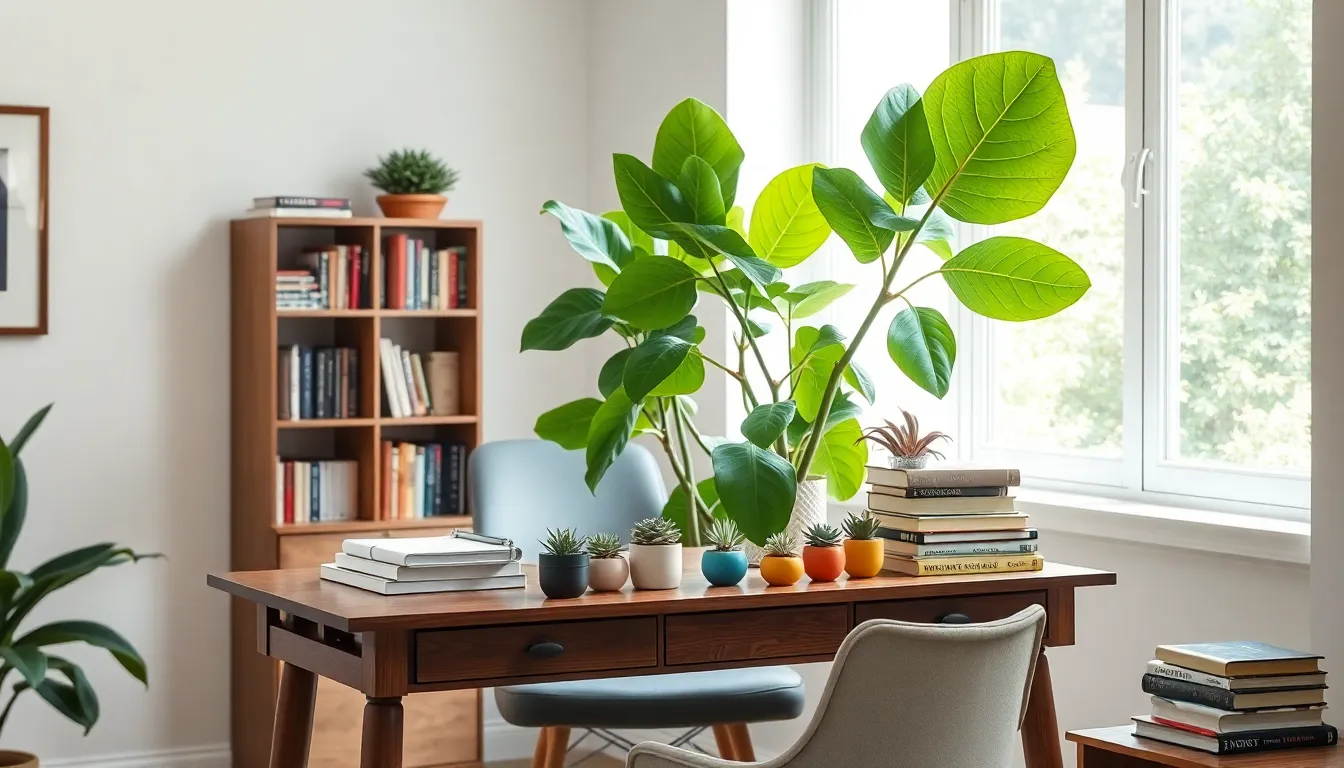
Converting your workspace into a literary garden merges the calming presence of plants with your book collection to create an inspiring and productive environment.
Position Large Plants Behind Your Desk Reading Area
Large plants positioned behind your desk create a lush green backdrop that transforms your workspace into a tranquil reading sanctuary. Fiddle leaf figs and monsteras work exceptionally well as statement pieces, visually softening the sterile feel of traditional office setups while improving air quality to support better focus and well-being.
We recommend placing these substantial plants at least three feet behind your desk to avoid crowding while maximizing their visual impact. The vertical presence of large plants mimics the height of towering bookshelves, creating a natural library atmosphere that encourages deep reading sessions.
Plants like rubber trees or bird of paradise also serve as natural room dividers, helping define your reading area within larger spaces. Their broad leaves provide a sense of enclosure that makes your literary corner feel more intimate and distraction-free.
Create Vertical Gardens Using Wall-Mounted Planters
Wall-mounted planters maximize your space while adding layers of greenery that complement your book displays without cluttering desk surfaces. Vertical gardens mimic the upward lines of stacked bookshelves, reinforcing the garden library theme throughout your office design.
Hanging planters filled with trailing plants like pothos or string of hearts create living curtains that frame your workspace beautifully. These cascading plants add movement and texture to otherwise static wall areas, making your reading environment feel more ever-changing and alive.
Small succulents arranged in geometric wall planters offer low-maintenance options that still provide visual interest and fresh energy. We suggest positioning these at eye level near your reading chair to create micro-environments that feel both calming and inspiring during work sessions.
Add Small Desk Plants Near Your Current Reading Stack
Small desk plants placed strategically next to your current reading materials create bursts of green energy that enhance your immediate workspace. Succulents, air plants, and small ferns work perfectly as reading companions, bringing nature closer to your hands without overwhelming your available desk space.
Positioning these plants near your book stacks creates natural vignettes that make your workspace feel more personalized and inviting. The proximity of living plants to your literature collection reinforces the garden library aesthetic while providing tactile elements that promote calm focus.
We find that plants in small ceramic pots or terracotta containers complement book spines beautifully, creating cohesive color palettes that tie your reading materials and greenery together seamlessly. Snake plants and ZZ plants offer particularly striking vertical lines that echo the spine arrangement of standing books.
Build a Greenhouse Library Corner for Maximum Aesthetic Appeal
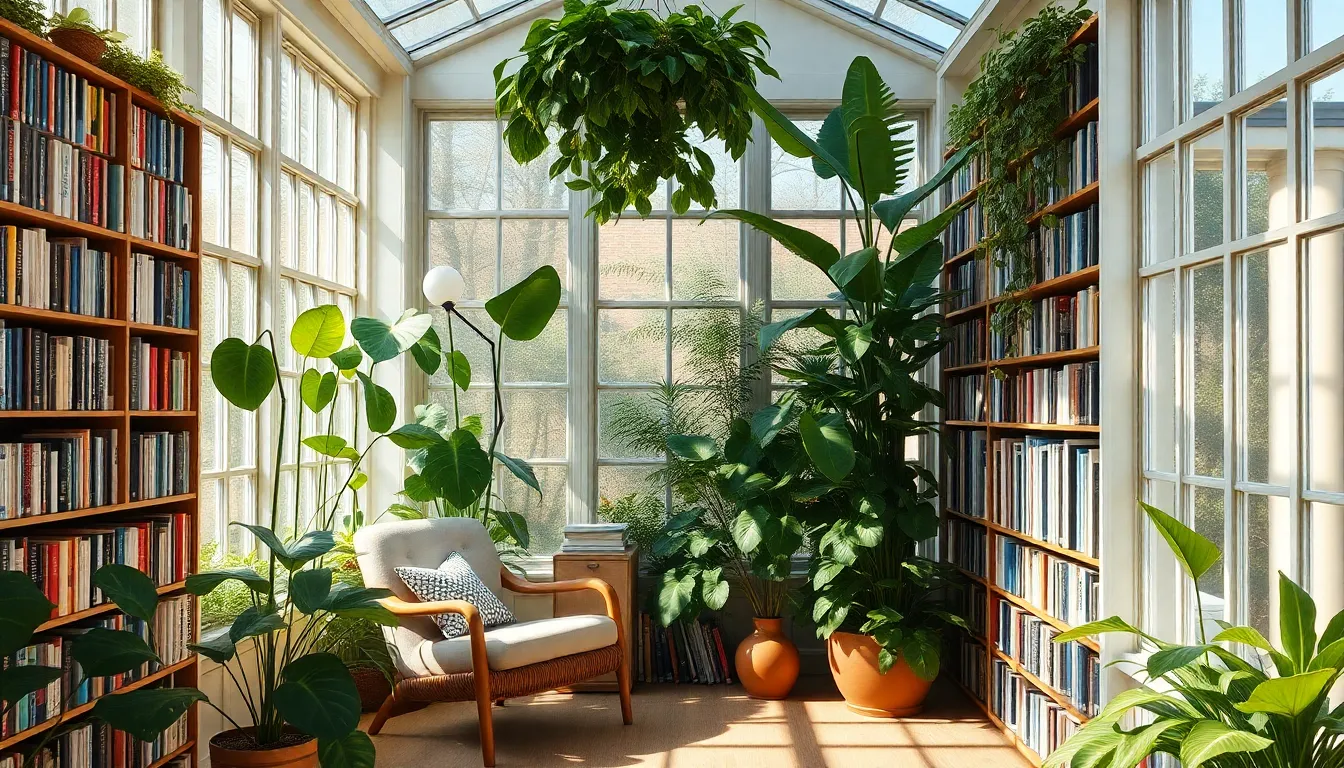
Building a greenhouse library corner transforms your reading space into a serene sanctuary where literature and nature create the perfect harmony. This dedicated area combines the enclosed feeling of a mini greenhouse with your book collection for maximum visual impact.
Install Floor-to-Ceiling Windows for Natural Light
Installing floor-to-ceiling windows maximizes the natural light essential for both plant health and comfortable reading. These expansive windows create an airy atmosphere that makes your library corner feel spacious and connected to the outdoors. Natural sunlight nurtures plant growth while providing the bright illumination needed for extended reading sessions without eye strain.
We recommend positioning your reading chair perpendicular to these large windows to avoid glare while still benefiting from the abundant light. The continuous flow of daylight through floor-to-ceiling glass creates ever-changing shadows and highlights throughout the day, adding visual interest to your plant and book displays.
Combine Tall Plants With Towering Bookshelves
Combining tall plants with towering bookshelves creates striking vertical layers that add depth and texture to your greenhouse library corner. Position statement plants like fiddle leaf figs or bird of paradise trees alongside your tallest bookcases to break up the linear monotony of book spines. These organic shapes provide visual relief while emphasizing the impressive height of your literary collection.
We suggest alternating between plant groupings and book sections to create rhythm throughout your vertical displays. Tall plants also soften the hard edges of wooden shelving while introducing natural colors that complement the varied hues of book covers.
Create Reading Alcoves Surrounded by Lush Greenery
Creating reading alcoves surrounded by lush greenery transforms your library corner into an intimate retreat perfect for deep literary immersion. Design these cozy nooks by positioning larger plants like monstera deliciosa and rubber trees to form natural walls around your reading chair. The dense foliage acts as a sound buffer while providing visual privacy from the rest of your home.
We recommend layering plants at different heights around your alcove to create an enveloping canopy effect. Place medium-height plants like snake plants and ZZ plants at eye level while using trailing varieties like pothos to cascade from higher shelves, completely surrounding your reading space with restorative greenery.
Master the Art of Book and Plant Photography
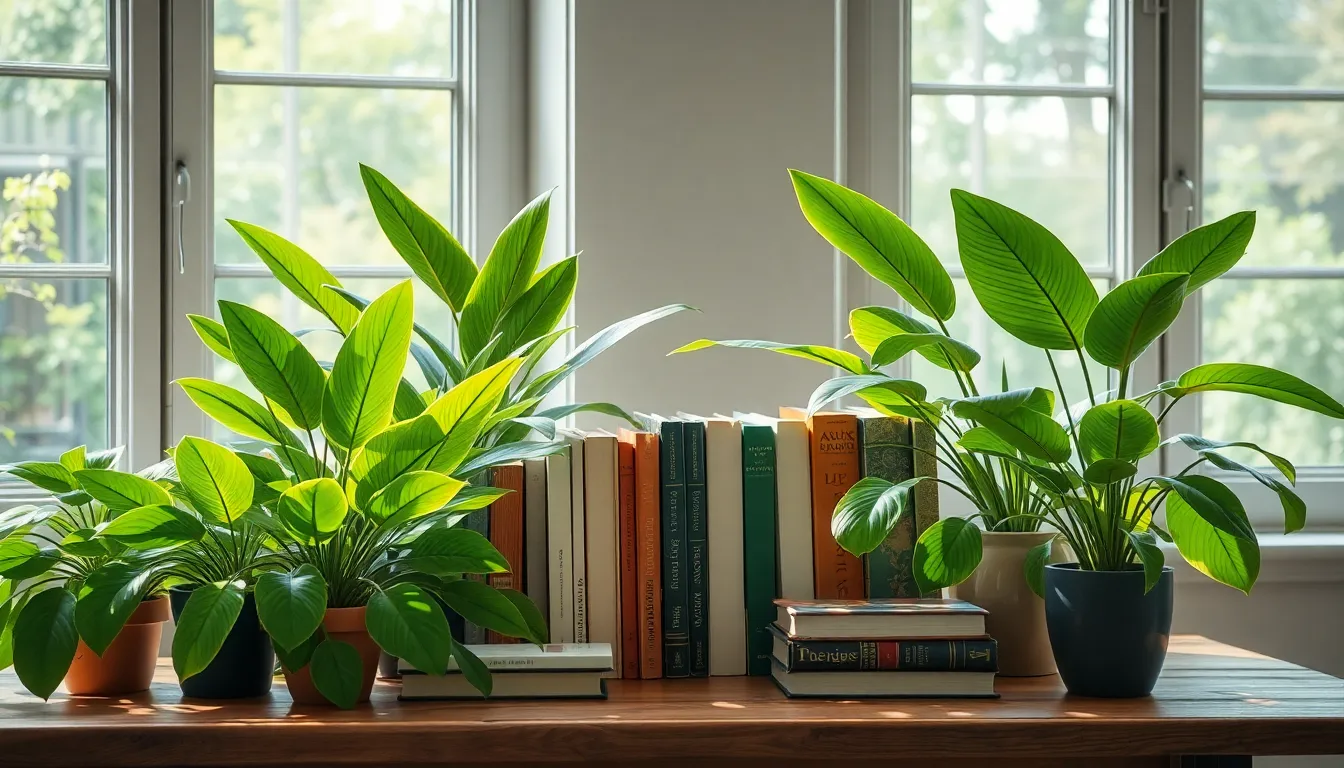
Capturing the perfect book and plant aesthetic requires mastering essential photography techniques that showcase both elements harmoniously. Strong photographic composition and proper camera settings help us balance exposure, aperture, and focus to reveal the delicate textures of leaves alongside literary treasures.
Use Natural Lighting to Highlight Textures and Colors
Natural light becomes our most powerful tool for revealing intricate details in both botanical subjects and book pages. Soft, diffused daylight streaming through windows enhances the true colors of plant foliage while bringing out the rich tones of vintage book covers and crisp white pages.
We position our arrangements near large windows during golden hour or on overcast days when light remains gentle and even. Harsh artificial lighting flattens the dimensional qualities that make books and plants so visually appealing, washing out the subtle variations in leaf patterns and paper textures.
Shadows created by natural light add depth and visual interest to our compositions. These organic shadows help define the shapes of both botanical elements and literary objects, creating a three dimensional quality that draws viewers into the scene.
Create Depth With Layered Plant and Book Arrangements
Layering creates dimensionality that transforms flat compositions into rich, captivating visuals. We place plants at varying distances from our camera, mixing foreground succulents with background trailing vines while positioning open books and stacked volumes throughout multiple planes.
Overlapping elements adds organic harmony to our book and plant photography. Cascading ivy tendrils that appear to emerge from book pages create natural connections between literary and botanical subjects, making the entire arrangement feel purposeful rather than randomly assembled.
We vary the heights of our elements by using book stacks as pedestals for smaller plants or allowing longer vines to drape across multiple books. This technique creates visual movement that guides the viewer’s eye through the entire composition while maintaining focus on key elements.
Apply Rule of Thirds for Balanced Aesthetic Compositions
Positioning plants and books along rule of thirds grid lines creates more captivating arrangements than centering every element. We place our most striking plant specimens or most beautiful book covers at intersection points where grid lines meet, naturally drawing attention to these focal areas.
Balance emerges when we distribute visual weight across different sections of our frame. A large monstera leaf in the upper left might balance perfectly with an open book displaying colorful illustrations in the lower right, creating harmony without symmetry.
We guide viewers’ eyes through deliberate placement that follows the natural flow patterns humans find most pleasing. This compositional approach makes our book and plant aesthetic photography more compelling and creates the polished look that performs well on social media platforms.
Conclusion
The books and plants aesthetic offers us a perfect way to transform our living spaces into havens of tranquility and inspiration. We’ve discovered that this timeless combination doesn’t just look beautiful—it actively enhances our well-being and creates environments where we can truly thrive.
Whether we’re crafting cozy reading nooks with trailing vines or building impressive greenhouse library corners we now have the tools to make our vision reality. The key lies in choosing the right plants for our space and lifestyle while thoughtfully arranging them alongside our beloved book collections.
Our homes can become Instagram-worthy sanctuaries that reflect our love for both literature and nature. By implementing these styling techniques and photography tips we’re ready to create spaces that inspire us daily and showcase the perfect harmony between books and plants.
Frequently Asked Questions
What are the mental health benefits of combining books and plants in home spaces?
Surrounding yourself with literature and greenery creates calming, inspiring environments that promote mental well-being. Plants improve air quality and reduce stress, while books provide mental stimulation and escapism. Together, they transform ordinary spaces into peaceful sanctuaries that support both relaxation and focus, making your home feel more inviting and restorative.
Which plants work best for creating a cozy reading nook?
Trailing plants like golden pothos and English ivy are ideal for reading nooks as they create intimate green borders around seating areas. These low-maintenance plants can be placed in hanging planters to frame your reading space without taking up floor space. Their cascading foliage adds natural beauty while maintaining the cozy atmosphere perfect for reading.
How can I style my bookshelves with plants without damaging my books?
Use low-maintenance plants like succulents and snake plants that require minimal watering to prevent moisture damage. Place small potted plants as natural bookends and ensure proper drainage in all planters. Position plants between book spines for visual interest, and choose containers that complement your book covers while protecting your collection from water damage.
What types of plant pots complement different book collections?
Match terracotta pots with vintage book bindings for a nostalgic, traditional library feel. Choose neutral ceramic planters for modern book collections to maintain a clean, polished appearance. For bohemian reading spaces, woven baskets add organic texture and balance eclectic book collections while creating a cohesive design statement.
How do I create Instagram-worthy flat lay photos with books and plants?
Arrange open books alongside trailing vines, positioning tendrils to appear emerging from pages. Coordinate colors between plant foliage and book covers for visual harmony. Add natural props like dried flowers and wooden accessories for texture. Use natural lighting near windows during golden hour and apply the rule of thirds for balanced, captivating compositions.
What’s the best way to transform a home office into a literary garden?
Position large plants like fiddle leaf figs and monsteras behind your desk to create a lush backdrop that improves air quality and focus. Install wall-mounted planters to maximize space and add greenery layers. Place small desk plants near reading materials to create personalized vignettes that reinforce the garden library aesthetic throughout your workspace.
How can I create a greenhouse library corner in my home?
Install floor-to-ceiling windows to maximize natural light, benefiting both plant health and reading comfort. Combine tall plants with towering bookshelves to add depth and texture. Create reading alcoves surrounded by lush greenery for intimate retreats. This setup merges the enclosed feeling of a mini greenhouse with your book collection for maximum aesthetic appeal.
What lighting works best for photographing books and plants together?
Natural lighting near large windows produces the best results for highlighting textures and colors. Shoot during golden hour for warm, soft light or on overcast days for even illumination. Avoid harsh direct sunlight that creates unflattering shadows. Layer elements in your composition and use the rule of thirds to create depth and visual balance in your photos.

